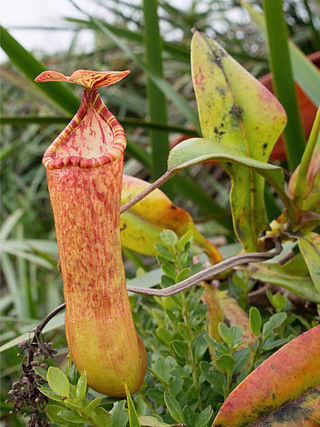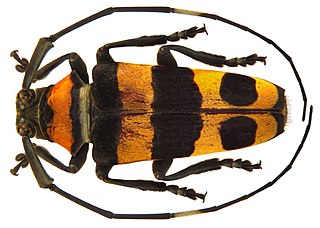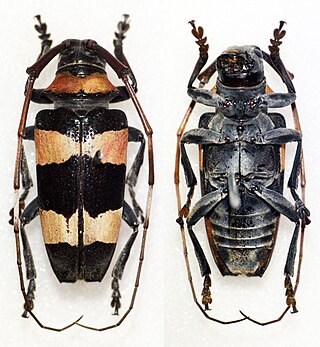
Pseudolarix amabilis is a species of coniferous tree in the pine family Pinaceae. The species is commonly known as golden larch, but being more closely related to Keteleeria, Abies and Cedrus, is not a true larch (Larix). P. amabilis is native to eastern China, occurring in small areas in the mountains of southern Anhui, Zhejiang, Fujian, Jiangxi, Hunan, Hubei and eastern Sichuan, at altitudes of 100–1,500 m (328–4,921 ft). The earliest known occurrences are of compression fossils found in the Ypresian Allenby Formation and mummified fossils found in the Late Eocene Buchanan Lake Formation on Axel Heiberg Island.

Abies amabilis, commonly known as the Pacific silver fir, is a fir native to the Pacific Northwest of North America, occurring in the Pacific Coast Ranges and the Cascade Range. It is also commonly referred to as the white fir, red fir, lovely fir, Amabilis fir, Cascades fir, or silver fir. The species name is Latin for 'lovely'.

Volcán Chingo is a stratovolcano on the border between Guatemala and El Salvador. The largest point on the Guatemala/ El Salvador border is Volcán Chingo at 5,823 feet. It is also known to be the second highest of a group of volcanoes in the SE Guatemala region. The population of people living within 30 km of the Volcán Chingo is estimated to be around 867,678 people. There are no historical eruptions documented for this volcano but it is currently active. The exact volcano number when trying to locate it in the Smithsonian website is 342170.

Nepenthes sumagaya is a tropical pitcher plant native to the Philippines. It is known only from Mount Sumagaya in north-central Mindanao, where it grows in open areas at elevations from 1600 m above sea level to the summit at 2247 m. It is sympatric with N. pantaronensis and possible hybrids between these species have been recorded. Owing to its unusual combination of morphological characters, N. sumagaya has no obvious close relatives in the genus.

Phalaenopsis amabilis, commonly known as the moon orchid or moth orchid in India and as anggrek bulan in Indonesia, is a species of flowering plant in the orchid family Orchidaceae. It is native to the Indonesia and Australia, and widely cultivated as a decorative houseplant. It is an epiphytic or lithophytic herb with long, thick roots, between two and eight thick, fleshy leaves with their bases hiding the stem and nearly flat, white, long-lasting flowers on a branching flowering stem with up to ten flowers on each branch.

Linnaea amabilis, also known under the synonym Kolkwitzia amabilis and the English name beauty bush, is a species of flowering plant in the family Caprifoliaceae. It is a deciduous shrub grown as an ornamental plant. In China, where it originated, the plant is called wèi shí (蝟实).

Cereopsius is a genus of longhorn beetles of the subfamily Lamiinae, containing the following species:

Cereopsius mimospilotus is a species of beetle in the family Cerambycidae. It was described by Stephan von Breuning in 1980. It is known from the Philippines.
Cereopsius javanicus is a species of beetle in the family Cerambycidae. It was described by Stephan von Breuning in 1936. It is known from Borneo and Java.
Cereopsius pulcherrimus is a species of beetle in the family Cerambycidae. It was described by Stephan von Breuning in 1942. It is known from Sumatra.

Cereopsius arbiter is a species of beetle in the family Cerambycidae. It was described by Francis Polkinghorne Pascoe in 1885. It is known from Borneo.
Cereopsius satelles is a species of beetle in the family Cerambycidae. It was described by Francis Polkinghorne Pascoe in 1885. It is known from Borneo.

Cereopsius alboguttatus is a species of beetle in the family Cerambycidae. It was described by C. Waterhouse in 1878. It is known from Borneo.

Cereopsius luhuanus is a species of beetle in the family Cerambycidae. It was described by Heller in 1896. It is known from Sulawesi and Moluccas.
Cereopsius obliquemaculatus is a species of beetle in the family Cerambycidae. It was described by Karl-Ernst Hüdepohl in 1989. It is known from Borneo.

Cereopsius praetorius is a species of beetle in the family Cerambycidae. It was described by Wilhelm Ferdinand Erichson in 1842, originally under the genus Lamia. It is known from the Philippines.

Cereopsius quaestor is a species of beetle in the family Cerambycidae. It was described by Newman in 1842, originally under the genus Monohammus. It is known from the Philippines and Moluccas.
Cereopsius sexnotatus is a species of beetle in the family Cerambycidae. It was described by James Thomson in 1865. It is known from Malaysia and Java.
Cereopsius vittipennis is a species of beetle in the family Cerambycidae. It was described by Warren Samuel Fisher based on specimen(s) from Mount Kinabalu in 1935, originally under the genus Epepeotes. It is known from Borneo.
Musivavis is a genus of euenantiornithine bird from the Early Cretaceous (Aptian) Jiufotang Formation of Liaoning Province, China. The genus contains a single species, Musivavis amabilis, known from a nearly complete, articulated skeleton.












